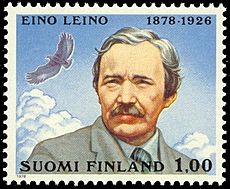Eino Leino facts for kids
Quick facts for kids
Eino Leino
|
|
|---|---|
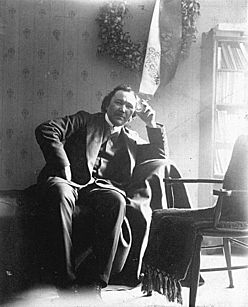
Eino Leino in 1912
|
|
| Born |
Armas Einar Leopold Lönnbohm
6 July 1878 Paltaniemi, Paltamo, Finland
|
| Died | 10 January 1926 (aged 47) Tuusula, Finland
|
Eino Leino (born Armas Einar Leopold Lönnbohm; 6 July 1878 – 10 January 1926) was a Finnish poet and journalist who is considered one of the pioneers of Finnish poetry and a national poet of Finland. His poems combine modern and Finnish folk elements. Much of his work is in the style of the Kalevala and folk songs in general. Nature, love, and despair are frequent themes in Leino's work. He is beloved and widely read in Finland today.
Leino's birthday on 6 July was named Eino Leino Day (Eino Leinon päivä) as well as day of Finnish poetry and summer in 1992, and it is an established Finnish flag day.
Early life
Eino Leino was baptized as Armas Einar Leopold Lönnbohm in Paltamo as the seventh and youngest son in a family of ten children. Leino's family lived in the Hövelö house in Paltaniemi village. Leino's father had changed his name from Antti Mustonen to Anders Lönnbohm to improve his chances of marrying his future upper-class wife, Anna Emilia Kyrenius. Eino's older brother Kasimir Leino was an important cultural figure in Finland. He was a poet, critic, and theatre director. Eino and Kasimir Leino founded a literature journal together in 1898.
Leino published his first poem at the age of 12 and a collection of poems, Maaliskuun lauluja, at 18.
Leino's parents died while he was still in school. He started school in Kajaani and continued in Oulu and Hämeenlinna, where he boarded with relatives. After graduating from the Hämeenlinna secondary school, Leino started studying at the University of Helsinki.
Writing career
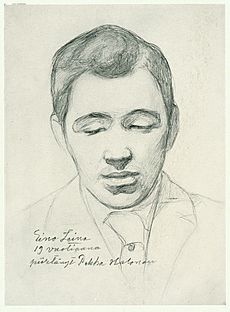
Early in his career Eino Leino was much loved and praised by the critics. He joined literary and newspaper circles and became a member of the Young Finnish circle. Among Leino's friends were the artist Pekka Halonen and Otto Manninen, who gained fame as a poet and translator.
As early as November 1917, Eino Leino had annoyedly warned in the Sunnuntai magazine that the country was "on the brink of civil war," and fiercely criticized the Socialists as they set out to "pursue their cause with civil blood and the stings of a foreign conqueror" (No. 40-41 / 1917). The political situation, which escalated into the Finnish Civil War, was a bitter experience for Leino, who had always written for tolerance and also appreciated the labor movement from which he had good friends. Leino experienced the events of the spring of 1918 in the Red-conquered Helsinki, and he described his experiences in the report novel The Conquest of Helsinki (1918). He greeted the German Baltic Sea Division, which had invaded southern Finland and conquered Helsinki, as a liberator. But on the other hand, Leino later drove a general amnesty for Red Side line men and women in prisons and demanded the abolition of the death penalty. In April 1918, Leino's six-part series of articles called "For the Finnish Workers" was published in the Social Democratic magazine Työn valta ("Power of Labor"), in which he, as an impartial writer belonging to the "civilized poverty", strongly appealed for peace and mutual understanding. “Social democracy would no longer have a future in Finland unless it was able to internalize the "eternal ideals" of legitimacy, democracy and civil liberty,” he wrote.
After the Finnish Civil War, Leino's idealistic faith for national unity collapsed, and his influence as a journalist and polemicist weakened. He was granted a State writer's pension in 1918 at the age of forty. Although publishing prolifically, he had financial problems and his health deteriorated. "Life is always a struggle with eternal forces," Leino said in a letter in 1925 to his friend Bertel Gripenberg.
Leino published over 70 books of poems and stories. The most famous of these are the two poem collections Helkavirsiä (1903 and 1916), in which he extensively uses Finnish mythology and folklore.
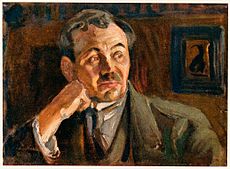
In addition to writing poetry, Eino Leino wrote in newspapers about theatre and culture in general, and translated works of important writers such as Runeberg and Goethe. He was the first person in Finland to translate Dante's Divine Comedy into Finnish.
In the summer of 1921, Leino traveled to Estonia for a written tour organized by the Finnish-Estonian friends Aino and Gustav Suits. With his poetry evenings, presentations and celebrations in Tartu and Tallinn, the trip became a success, and Eino Leino was received everywhere as a significant poet. After his trip to Estonia, he signed his third marriage to bank clerk Hanna Laitinen. The desperate attempt to gain support and security ended almost immediately in the separation of the spouses. In 1921, Leino applied for exemption from Finnish citizenship. He wrote letters to President K. J. Ståhlberg and Estonian Head of State Konstantin Päts asking to become an Estonian citizen. Leino was tired of the lack of scholarships and the criticism he received.
Leino was married three times and had one daughter, Helka. He died in 1926 at the age of 47 and later he was buried at the Hietaniemi Cemetery in Helsinki. Already at that time as a famous man, he was buried at the expense of the state, and the funeral was attended by President L. K. Relander and other statesmen of the country.
The most detailed biography of Leino was written in 1930s by his lover and colleague L. Onerva. In the dramatic story Onerva is also writing about her own life.
There is no absolute certainty about the cause of Eino Leino's death. In the work of the writer Hannu Mäkelä, Mestari, the cause of Leino's death is described as advanced spinal cord disease and calcification of blood vessels, which is why blood had leaked into the brain. It is said that it had previously confused Leino's abdominal functions. According to Mäkelä, the cause of death was determined by both Dr. Wasastjerna and Dr. Lindén. .....
Literary style and importance
Leino is held to be the first and most important shaper of national romanticism in Finnish literature. Actually, Leino coined the term national neoromantism by himself to characterize the works by talents of young Finland such as composer Jean Sibelius, painter Akseli Gallen-Kallela and architect Eliel Saarinen.
Leino's style developed during his 35 year career. In his early works, including his most famous collection Helkavirsiä (1903) influence of the national epic Kalevala is visible.
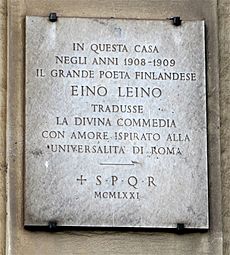
In the middle of his career Leino translated classics of world literature to Finnish. At the same time he wrote his own works in several genres: poetry, plays, essays, reviews and other pieces of journalism. His work encompasses a wide emotional range, anything from profound love to misanthropy and biting criticism.
In his last years, after struggles in his personal life, Leino returned to the national romantic themes of his youth.
See also
 In Spanish: Eino Leino para niños
In Spanish: Eino Leino para niños
- The Eino Leino Prize
- The Eino Leino Statue
- Johan Ludvig Runeberg
- Poet and Muse


